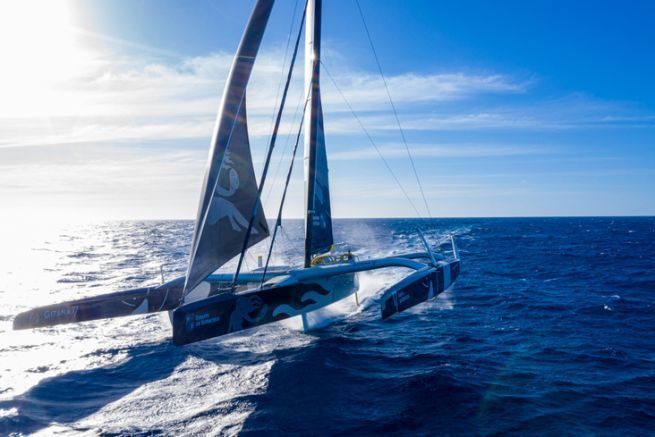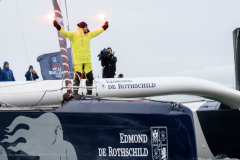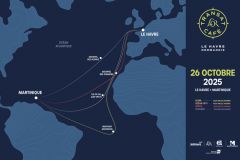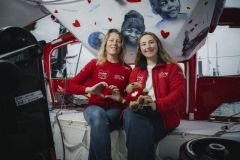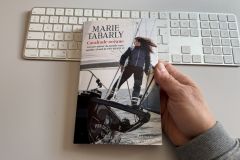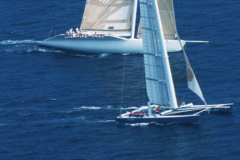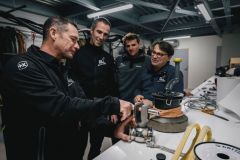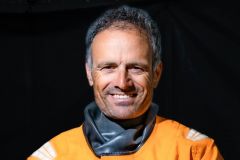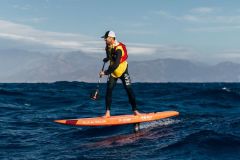euros a few days before the start, what is your state of mind? You are one of the teams who know their boat best. What are your ambitions for this Jacques Vabreeuros?
Charles Caudrelier We're ready. It's been an active year. We changed a lot of things, especially a lot of appendages. We prepared for this race and got to grips with the new appendages. We have all the potential to win and we have the ambition to do so.
The new boats also come to win. But they have less pressure, because they know that they are not at 100% of their potential, precisely because they are so young. Everyone has prepared. Everyone has good sponsors and the means to prepare well. Everyone has the ambition to win.
Franck Cammas: It's a great race, and an important event in the Ultim program, just like the Route du Rhum. It is an important meeting for the Ultims and all the classes. It's the third major ocean racing event after the Vendée Globe and the Route du Rhum. It's good to be there. The new boats have a lot of potential and no guarantee of breaking. They can very well finish "whole".
What work has been done on the Maxi Edmond de Rothschild and in particular on the Euro appendages?
Franck Cammas: There are always small evolutions. We try to push the limits that appear as we progress. We develop one characteristic, another one is put in warning. We don't stop developing this boat. We are pushing the hydrodynamic limits with the cavitation of the appendages.
We changed the 3 rudders, which were the cause of our stop on the Jules Verne. We have also changed other load-bearing parts, the foils and the wing, the load-bearing part under the daggerboard. But we will not use these new foils on the Jacques Vabre. We're not satisfied enough. We have made great progress with the hulls and the daggerboard, with new shapes. We're keeping up with the times, because the competitors who are coming out with new boats all have new appendages.
Charles Caudrelier: The objective is to fly earlier and faster. If we want to fly very early, we need big enough appendages. Today, we take off from 26 knots. Before, it was more like 28/29 knots. If we could take off from 23 knots, we would be happy! Once in the air, we put the turboeuros!
Today we know how to make appendages that could take off at 20 knots, but they would be much bigger, heavier and thicker. At 40 knots, there would be cavitation - air bubbles in the water - because the appendage would be too heavy. Cavitation destroys our appendages and it appears around 40 knots. Today, we manage to reach 43 knots with the new foils, but we hit a wall again beyond this speed. It's difficult to make a versatile appendage.
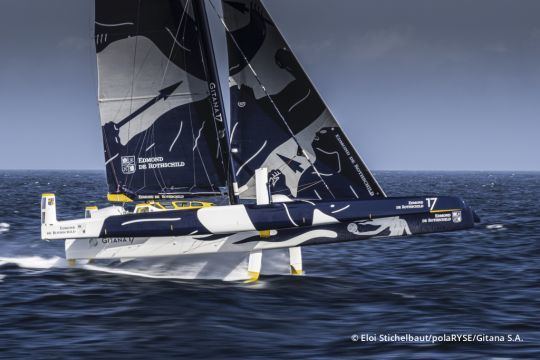
Unlike the other teams, you are two skippers on the Maxi Edmond de Rotschild. Is this a strength and how are the roles divided up on board?
Franck Cammas: It is a strength to work together all year round and to set off together on this transatlantic race. Most of the pairs are formed on the sporting part and the race itself. Having thought together about the evolution of the boat and having lived on it for a few years allows us to know it much better. In theory, it allows us to adjust and master it. This is the strength of this co-skippering organization, especially in the Transat Jacques Vabre.
Charles Caudrelier: There are two situations. At sea, when you're sailing double-handed, 80% of the time you're single-handed part-time. We alternate between resting and making decisions. There is also the weather, for which we are helped by a routing on land. Erwan Israël and Stanley Honey are our routers. This allows us to focus on performance and less on the weather.
Then there is the land. We divide the roles according to the aptitudes and qualities of each one. Franck has had a lot of boats, and has designed many of them. He is very comfortable with the design part. I manage the rest, I prepare the navigation
What are the constraints and advantages of a double-handed race format compared to solo or crewed racing?
Franck Cammas: There are not many drawbacks. This format is very adapted to multihulls. They require a lot of attention because they go fast. You have to be on a line that you never go over so as not to risk capsizing. In solo, it requires a lot of vigilance. When sailing double-handed, you have less margin against this limit. You can exploit 100%. When sailing solo, you can't take the boat to its limit and its potential.
I like this formula a lot. It leaves less to chance and risk-taking. It's a smart thing to do. Nobody risks anything. It's more like a real regatta like we like to do with a crew. It's not the same atmosphere on board. We share with two people. It's different from solo sailing and rather pleasant. You experience something strong on this kind of race and on this boat. When you are single-handed, you share things with people you don't see, on land, or on the other side of the phone.
Charles Caudrelier: It's a format we love. In solo, in multihull, you have the stress of capsizing. As soon as you fall asleep, you stress, so you don't sleep much. In double-handed, it's exciting. It's a whole exercise to manage. You can exploit the boat to the full, exchange, share. Even if we share all year long. When you play a project on a double-handed boat, we share our points of view. It brings a new look or a fresh perspective.
Solo racing is very special. You do your race alone even if there is a team behind you. Here, we share the good emotions, as well as the bad ones. It feels good. You are in good harmony with your teammate and humanly speaking it is nice. As for the performance, you really feel like you are exploiting the boat. When you are double-handed, you sleep better even if you think about capsizing!
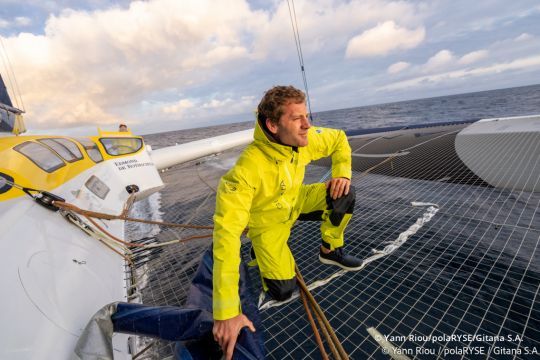
What do you think of the new Euro race courses? What difference does it make?
Charles Caudrelier: It's a longer course, adapted to our boats. I think it's great to arrive in the same week. We will try to respect the arrival by boat size, otherwise it will be unreadable for the public.
We know the course. The first part is a Jacques Vabre as before. The second part e part is always interesting. It's a course that we do with a crew, like in the Volvo Ocean Race. So we know it too. It's interesting on the way down and on the way back up.
Franck Cammas: in Salvador de Bahia, we will have done a good third of the race whereas before it was the finish. It's not the same race. It's a north-south course, with a lot of weather transitions. It's a round trip and the race is going to be open all the way to the end because of that. There will also be some race management, like for the men and the boats. The course is longer, there will be more fatigue. It's not the same rhythm.

How do you feel about the competition, both in personal and material terms (boat)?
Charles Caudrelier: It's hard to say, because we haven't had many races. We have a pure analysis of the boats. We know Sodebo well. It has made good progress. It is not very fast and did not fly at the beginning. Since last year, it flies and progresses. His performances are very close to ours even if we always beat him. He has strong points downwind and these are the conditions we are likely to encounter.
François' boat, SVR-Lazartigue, we have only met in light airs, but it goes very fast. We think it's a very good boat. He has optimized it with his experience and the analysis of our boat. Gitana has been a performance reference for 4 years.
Banque Pop, is the second boat in the stable. The first one was not very successful. The 2nd e is inspired by Gitana. It is very good. We think it's very efficient. They're going to be in the game, but they're just young. They're going to perform well.
Yves Le Blévec has a boat that we have raced. He goes very fast. It's hard to beat him every time. His boat is reliable. It is older than us in terms of design, but it performs well.
The set is very homogeneous. This is the first time. Before, there was always one boat that dominated the fleet. After this, we only met in certain conditions, so we don't really know. But all of them will be fast.
Franck Cammas: The two boats launched this year are very consistent. There are no surprises. They have gone in the direction that seems to work, and for which Gitana, in 2017, was a precursor. The technical choices converge around these boats, around our boat. But they have gone further. They have made refinements. That's normal.
Starting from a blank page and making new parts allows to progress in all these details. That's the whole point of having a new boat. They will go very fast in time. It takes time to get to know the boat and to get the right settings. But on paper they will go fast.
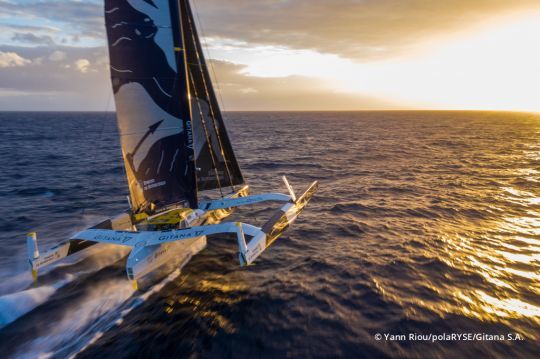
After the Transat Jacques Vabre, what are your main projects?
Franck Cammas: The Route du Rhum for Charles. It is the flagship Ultime race before the solo round the world race in 2023. The Jacques Vabre allows us to prepare for this race and to establish a good development list after the race. We'll know even more about how to develop the boat for the Route du Rhum during the 10 months leading up to it. It's an important year.
Charles Caudrelier: We hope to do the Jules Verne Trophy on December 25, 2021. We still have the ambition to bring back the boat and to prepare it.
To avoid complications, we agreed from the beginning of the project. It wasn't easy because we both wanted to do the Route du Rhum and the Round the World Race. That's how it came about. I really wanted to do a Route du Rhum in a multihull. I've never been able to do it. When I started my career, it was my main objective. Franck has already done it and won. He agreed to let me do it. And it made sense to go around the world behind. I really wanted to go solo and we respected each other's desires.
